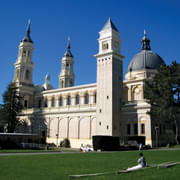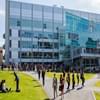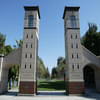San Francisco State University (SFSU) is a public university in San Francisco, California, which is located in the western side of the city. It's a very large school with approximately 19,337 undergraduates (total enrollment ~ 22,357). Admissions are less selective with an acceptance rate recently at approximately 96.1%. Some popular majors include Business Administration, Psychology, Biology, Communication Studies, and Computer Science. The six-year graduation rate approximates 50-55% instead of what was asserted. Median earnings of SFSU graduates are in the range of US$68,077 a couple of years post-graduation in most programs; the entire median 10-year after-entry value asserted ($49,900) is less than what recent data indicates in most instances.
University of San Francisco (USF) is a private Jesuit university in San Francisco, California, on a hilltop campus overlooking the city. It is a medium-sized school with roughly 5,287 undergraduates and overall enrollment ~ 8,900. Admissions are moderately selective, with an acceptance rate of about 50.8% as of the latest year (far lower than earlier claim of 71%). Popular programs include Business, Nursing, Biology, Psychology, and Communication. The six-year graduation rate is roughly 76%. USF graduates have a median salary of US$89,812 ten years after matriculation, far above the $61,300 that you provided.
| San Francisco State University | University of San Francisco | |
|---|---|---|
| Collegedunia Score | 4.1 Out of 10 | 4.1 Out of 10 |
| ranking (overall) | # 1401 QS World University 2026 # 1201 QS World University 2025 # 1388 Center for World University Rankings 2025 | # 1201 QS World University 2026 # 1201 QS World University 2025 # 1417 Center for World University Rankings 2025 |
| Programs | UG Programs -72 PG Programs -35 | UG Programs -45 PG Programs -33 |
| Acceptance Rate | 90.0 % | 51.0 % |
| Exam Score | IELTS-7 SAT-950 TOEFL-80 | IELTS-6 SAT-1100 TOEFL-65 |
| Cost to Study | Average Tuition Fees 9256 [For UG Program] Average Tuition Fees 10700 [For PG Program] Hostel + Meal - 31970 Per Year | Average Tuition Fees 52920 [For UG Program] Average Tuition Fees 38520 [For PG Program] Hostel + Meal - 31960 Per Year |
| placement (average package) | Some of the programs and the average salary are as follows: Masters of Arts: $160,000 Bachelor of Science: $68,000 MBA: $60,000 | Some of the programs and the average salary are as follows: MBA: $117,000 Masters in Science: $77,000 Executive Masters: $72,000 Bachelor of Science: $70,000 Master (Other): $54,000 Bachelor of Arts: $52,000 |
| application requirements | Submit official transcripts Submit LORs Submit personal statement Submit English language proficiency scores Check program specific requirements | Submit official transcripts Submit LORs Submit personal statement Submit English language scores Check program specific requirements |
| CollegeDunia Reviews | 7.6/10 Read 3 reviews | 7.0/10 Read 9 reviews |
Top Courses Comparison
| ranking | # 301 for Business by Academy Ranking of World Universities 2021 | # 122 for Business by US News 2025 |
| exam scores | Duolingo - 120/160IELTS - 6.5/9PTE - 59/90TOEFL - 88/120 | Duolingo - 120/160IELTS - 6.5/9PTE - 61/90TOEFL - 90/120 |
| cost to study | Total Cost (Tuition + Living) -23124 | Total Cost (Tuition + Living) -39600 |
| documents required | #Letter of Recommendation + Statement of Purpose | #Letter of Recommendation + Statement of Purpose |
| application dates | Nov 1, 2025 (Application Deadline For Spring 2026 Intake) | Jan 15, 2025 (Round 2 Application Deadline For Fall Intake) Mar 15, 2025 (Round 3 Application Deadline For Fall Intake) May 15, 2025 (Round 4 Application Deadline For Fall Intake) Jun 15, 2025 (Round 5 Application Deadline For Fall Intake) |
Other Popular Comparisons
| General Facts | San Francisco State University | University of San Francisco |
|---|---|---|
| Type of University | University | University |
| Established | 1899 | 1912 |
| Student:Faculty Ratio | 23:1 | 13:1 |
| Male:Female | 44% Male, 56% Female | 38% Male, 62% Female |
| Location Facts | The main campus of the university is located in San Francisco, California. In addition to the main campus, the school also has three satellite campuses. The Downtown Campus is part of the Lam Family College of Business and the College of Extended Learning and is located in the office area of Westfield San Francisco Centre. The Sierra Nevada Field Campus is located in Sierra County near Yuba Pass and the Sierra Valley and offers accredited courses to the general public. The Romberg Tiburon Campus is a 53-acre research campus located in Marin County. It is home to the Estuary and Ocean Science Center, a marine research lab. | The University of San Francisco has its main campus at the Hilltop Campus. There are several other campus located at USF Downtown San Francisco Campus, The Orange County Campus, The Pleasanton Campus, The Presidio Campus, The Sacramento Campus, The San Jose Campus, The Santa Rosa Campus. |
| Library | The mission of the J. Paul Leonard Library is to empower its University constituency with lifelong learning skills to identify, find, evaluate, use and communicate information in promotion of excellence in scholarship, knowledge and understanding. | The Library provides the resources, services, and spaces to develop the whole person, and actively engages the USF community in its educational, social, and scholarly activities. The library provides access to 1.5 million book on shelf and online. 57,000 streaming videos are available on the website, 2 billion articles are available for the students. |
| Campus Life | SF State has over 200 student organizations to get involved in. They include Academic, Arts, Cultural, Greek, Honor Societies, Media/Publication, Philosophical, Political, Pre-Professional, Religious, Service, Social, Social Justice, University Housing and Wellness organizations. Associated Students (AS) offers hundreds of community-oriented resources, events, services, scholarships, internships & student jobs, and is dedicated to the empowerment of SF State's diverse student body. Through a commitment to social justice & shared governance, the AS Board of Directors - SFSU's Student Body Government - acts as the official voice of students.Student Activities & Events partners with students to support organizations and clubs, facilitate programs and events that create community, develop the whole person, and foster a deep sense of connection to each other and our campus. The Campus Recreation Department is a student-driven department guiding development through transformative activities, creating a sense of belonging within our community, and being a key partner in integrating health and wellness across the University. | At USF, students take part in a broad range of academic, cultural, social, and political organizations. They also write for the school newspaper, work with university leaders through student government, work with visual and performing arts groups, and lend a hand in community service. Student clubs are a great way to empower and enrich yourself while meeting fellow Dons who share the same passion. Once you’re on campus, you’ll have more than 100 student clubs and organizations to join. Student Leadership and Engagement understands that you seek out involvement and leadership for a variety of reasons, including serving others, networking, building skills, discovering yourself, making new friends, and creating change. The Cultural Centers include the Gender & Sexuality Center and the Intercultural Center. The centers serve as both physical spaces on campus where students build community, and as outlets for student run programs that explore social issues and identity. |
| Hostel | #On campus - $14502 #Off campus (not with family) - $14502 #Off campus (with family) - $2966 | #On campus - $14330 #Off campus (not with family) - $14330 #Off campus (with family) - $3300 |
| Famous Alumni | Alvin Ailey – dance choreographer and activist Solomon Darwin – Professor of Business at Haas School of Business and known for his development of "smart village" frameworks for Indian villages | Carlos Baena, animator |
| City Life | A beautiful region filled with iconic landmarks independently owned businesses and trendsetting residents, San Francisco has long followed the beat of its own drum. Morphed and molded by its communities, the California metro area has been the heart of the bohemian lifestyle, the epicenter of the LGBT rights movement and the launching point of the technology era. Today, San Francisco is a complete universe in and of itself. But a housing crunch has made it difficult for the San Francisco metro area to accommodate its population, driving housing prices and rental rates sky-high and significantly increasing the cost of living. The reasons why tourists love visiting San Francisco are the same reasons why residents love living here. The area is home to dozens of award-winning restaurants, world-class museums and family-friendly activities that San Franciscans routinely take advantage of. The lack of affordable housing options has caused the region's homeless population to grow. Necessary expenses like food and transportation aren't cheap, either. Basic groceries and gas generally cost noticeably more than the national average. | A beautiful region filled with iconic landmarks independently owned businesses and trendsetting residents, San Francisco has long followed the beat of its own drum. Morphed and molded by its communities, the California metro area has been the heart of the bohemian lifestyle, the epicenter of the LGBT rights movement and the launching point of the technology era. Today, San Francisco is a complete universe in and of itself: Each neighborhood exudes its own personality, from the historic streets of the Mission District to the grassy hills of the Presidio to the bustling piers along the Embarcadero. Onerous zoning restrictions and residents' desires to stymie population growth have led to a drop in new housing units within city limits, causing San Francisco home prices and rental rates to rise significantly over the past several years. The lack of affordable housing options has caused the region's homeless population to grow. Necessary expenses like food and transportation aren't cheap, either. Basic groceries and gas generally cost noticeably more than the national average. |
| Weather |
San Francisco State University and University of San Francisco
Subject Strength & Global Rankings (2025/2026)
SFSU and USF are similarly well regarded locally in the Bay Area, but USF generally places higher in national reputation, professional careers, and salaries. In rank ordering data, USF tends to be ranked in higher ranks for general outcomes; SFSU is well regarded regionally particularly for public affairs, creative arts, and social sciences, but less so for long-term returns in most sources. USF's business, health, law, and ethical leadership strengths tend to elevate its global/national reputation.
General Information
USF, with an overall enrollment of approximately 8,900 and ~ 5,300 undergraduate students, is relatively smaller compared to SFSU, which has ~ 22,357 total students, ~ 19,300 undergraduates. USF's campus is small, residential, and centered; SFSU has a greater urban campus, higher number of undergrads, greater number of non-traditional and commuter students, greater diversity.
Acceptance Rate & Admissions
Admission to SFSU is extremely non-selective, with acceptance rate ~ 96.1%. USF is much more so today, with acceptance rate ~ 50.8%. USF admitted students have slightly better academic qualifications on average. Both institutions have moved to being more test-optional / less dependent on standardized tests in recent years.
Research Impact & Facilities
USF, being a private school with good resources, typically has greater per-student investment, better alumni outcomes, more professional programs (law, health, business) and internships and partnerships, particularly with its San Francisco location. SFSU, as a member of the California State University system, enjoys strengths in some applied majors, environmental studies, creative arts, and large lecture / commuter model, but less high-end research funding and prestige than USF.
Cost & Financial Aid
USF's tuition is high; its net price (after financial aid) is also high (~ US$44,104 average net price in recent years). SFSU's costs are much lower, particularly for California residents, and its net price is considerably lower. The percentage of students on aid, grants etc., varies; USF provides significant aid, yet most students are still left with high expenses.
Career Outcomes & Alumni Success
USF graduates also exhibit excellent long-term earning; USF median income 10 years after entry into college is ~ US$89,812. That is above many of the SFSU earnings estimates. SFSU median incomes are lower in most majors / programs; some SFSU majors perform well, but overall median is less. USF also sees a greater six-year graduation rate (~ 76%) compared to SFSU's ~ 50-55%. USF's location, prestige, alumni network, professional programs provide job placement, internships, and career advancement benefits.
















